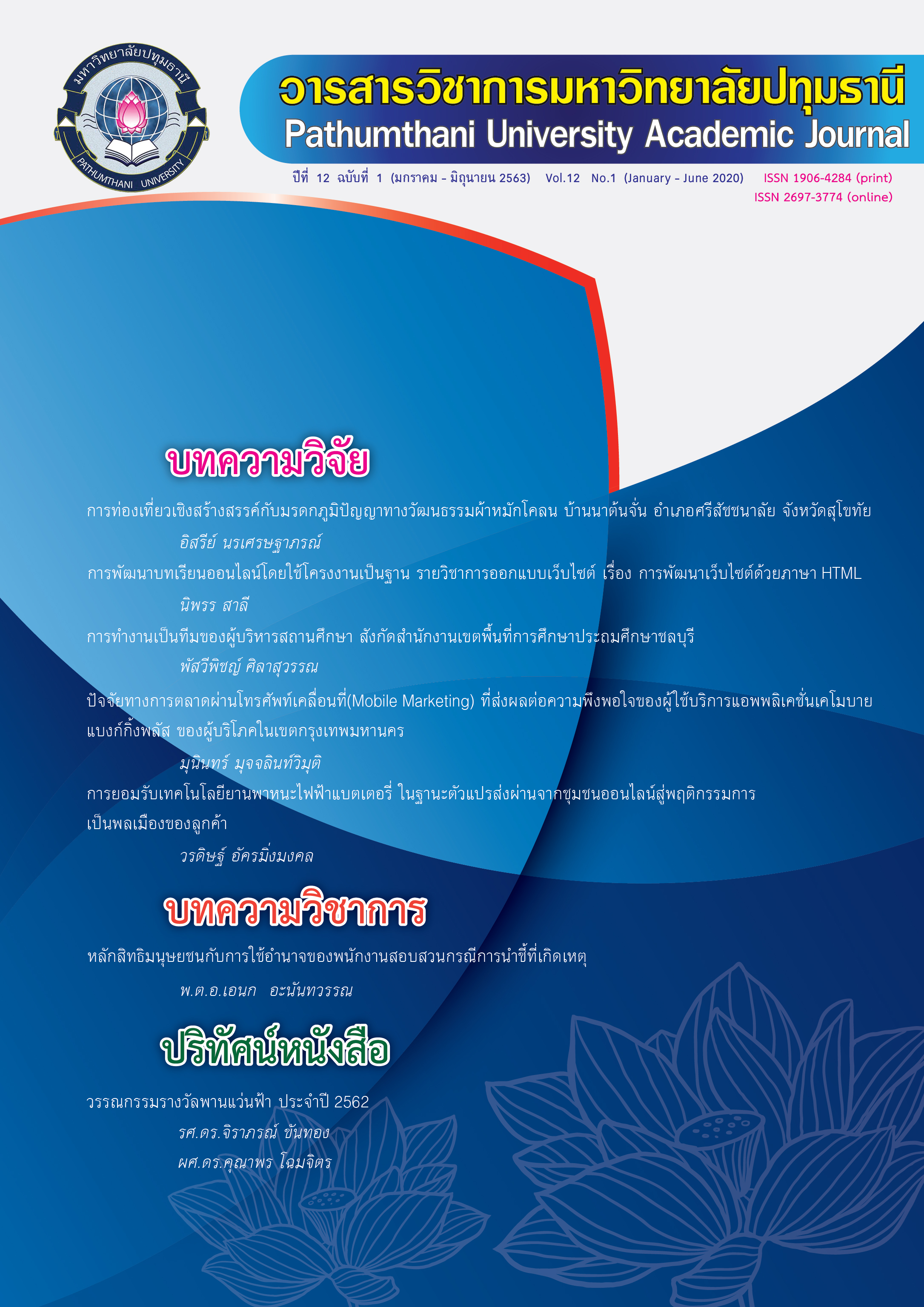MODEL OF THE CREATING OF EMPOWERMENT COMMUNITY FOR SUSTAINABLE OVERCOMING NARCOTICS IN LOPBURI PROVINCE
Keywords:
The creating of Empowerment Community for Sustainable Overcoming Narcotics, Community factor, Public participation factorAbstract
The purposes of this study were 1) to analyze impact between Community Factor and Public Participation Factor 2) to study the model of the creating of Empowerment Community for Sustainable Overcoming Narcotics in Lopburi Province. The sampling group which was selected purposively comprises 382 leaders who take important roles to create sustainable development in village and community level. The instruments used in the study are questionnaire and interview-based toward Theory and Research Framework. Simple statistics such as Frequency, Percentage for general data explanation, Means, Standard Deviation were employed to explain the relationship between factors (Community Factor and Public Participation Factor) with the creating of Empowerment Community for Sustainable Overcoming Narcotics in Lopburi Province. Multiple regression analysis for the relation between each factor by Stepwise Method with a significant level at .05 Hypothesis Test result showed that Community Factor such as Against Drug Abuse Policy, Strong Leader, Awareness of Narcotics Problem, Community Network and Coordination with related parties has impact to the creating of Empowerment Community for Sustainable Overcoming Narcotics with significant at level .05 especially Awareness of Narcotics Problem which is the highest impact. Public Participation Factor such as Participation to make decision, Participation to take action, Participation to take benefit and Participation in evaluation are impact to strengthen Community for overcoming narcotics with sustainability by significant level .05 especially Participation to take benefit has the highest impact.
References
ไกรสุข สินศุข. (2545 ). กระบวนการมีส่วนร่วมของชุมชนในการป้องกันยาเสพติด โดยวิธีการ วิจัยปฏิบัติการอย่างมีส่วนร่วม ตำบลบางพรม อำเภอบางคนที จังหวัดสมุทรสงคราม.ดุษฎีนิพนธ์ปริญญาปรัชญาดุษฎีบัณฑิต สาขาวิชาอาชญาวิทยาการบริหารงานยุติธรรม และสังคม. มหาวิทยาลัยมหิดล.
ตำรวจภูธรจังหวัดลพบุรี. (2558). เอกสารการดำเนินการแก้ไขปัญหายาเสพติดของจังหวัดลพบุรี.
พัชราวดี ตรีชัย. (2552). การวิเคราะห์ความเป็นชุมชนเข้มแข็งของหมู่บ้านหนองกลางดง ตำบลศิลาลอย อำเภอสามร้อยยอด จังหวัดประจวบคีรีขันธ์. ดุษฎีนิพนธ์ปริญญารัฐประศาสนศาสตรดุษฎีบัณฑิต. มหาวิทยาลัยเกริก.
มิ่งขวัญ คงเจริญ.(2554). การพัฒนารูปแบบการเสริมสร้างพลังอำนาจของชุมชนเพื่อเสริมสร้างความยั่งยืนของชุมชนแห่งการเรียนรู้. ดุษฎีนิพนธ์ปริญญารัฐศาสตรดุษฎีบัณฑิต.จุฬาลงกรณ์มหาวิทยาลัย.
เมตต์ เมตต์การุณจิต. (2553). การบริหารจัดการศึกษาแบบมีส่วนร่วม: ประชาชน องค์กรปกครองส่วนท้องถิ่นและราชการ. (พิมพ์ครั้งที่ 2). กรุงเทพมหานคร : บุ๊คพอยท์.
ศูนย์อำนวยการพลังแผ่นดินเอาชนะยาเสพติดแห่งชาติ. (2556). แผนปฏิบัติการพลังแผ่นดินอาชนะยาเสพติดแห่งชาติ. กระทรวงมหาดไทย.
สมบูรณ์ ธรรมลังกา. (2556). รูปแบบการเสริมสร้างความเข้มแข็งของชุมชนโดยใช้ภูมิปัญญาท้องถิ่นเป็นฐานในจังหวัดเชียงราย. ดุษฎีนิพนธ์ปริญญาครุศาสตรดุษฎีบัณฑิตสาขาวิชาการศึกษาและการพัฒนาสังคม. มหาวิทยาลัยราชภัฎเชียงราย.
สมหมาย แจ่มกระจ่าง และคณะ. (2551). “การเสริมสร้างการมีส่วนร่วมของประชาชน :กรณีศึกษา การจัดทำแผนชุมชนเทศบาลตำบลบางพระ จังหวัดชลบุรี”. วารสารการศึกษาและพัฒนาสังคม. ปีที่ 4 ฉบับที่ 2.
สิทธิณัฐ ประพุทธนิติสาร และคณะ. (2547). การถอดบทเรียนความสําเร็จของชุมชน ในการแก้ไขปัญหาสารเสพติดแบบครบวงจรและยั่งยืน. สํานักงานป้องกันและปราบปรามยาเสพติด.
สำนักงานคณะกรรมการป้องกันและปราบปรามยาเสพติด. (2549). 10 ชุมชนต้นแบบภาคตะวันออก : กรณีศึกษาประชาคมชุมชนเข้มแข็งในการจัดการกับปัญหายาเสพติด. กรุงเทพมหานคร : สำนักงานคณะกรรมการป้องกันและปราบปรามยาเสพติด.
Bandura, A. (1995). Self-efficacy in changing societies. Cambridge, UK: Cambridge University Press.
Bass, B.M. and Avolio, B. J. (1991). Improving Organizational Effectiveness Through Transformational Leadership. London: Sage.
Cohen, John M., and Uphoff, Noman T. (1980).“Participation’s Place in Rural Develop : Seeking clarity Through Specificity”. World Development.
Dennies, E. P. (1979). “Communities: A Survey of Theories and Methods of Research”. New York: acmillanpub Co., Inc.
Ephross, P H, and Vassil, T. V (2005). Groups that work Structure and process. (2nd ed.). New York: Columbia University Press.
Kasmel, A. (2011). Evaluation as a tool for community empowerment, a study on three community Initiatives in Rapha, Estonia. The Faculty of Health Sciences University of Southern Denmark.
Kieffer, C. (1984). Citizen empowerment : a developmental perspective. Prevention in Human Services.
Maslow, Abraham H. (1987). Motivation and Personality. (3rd ed.).
Ohmer, M.and Beck, E. (2006). “Citizen participation in neighbourhood organizations in poor Communities and its relationship to neighbourhood and organizational collective efficacy”. Journal of Sociology and Social Welfare.
Perkins, D.D. and Zimmerman, M.A. (1995). “Empowerment theory, research, and Application”. American Journal of Community Psychology.
Tropman, J. (2003). Making meetings work: Achieving high quality group decisions. Thousand Oaks, CA: Sage
United Nations. (1981). Yearbook of International Trade Statistics. United Nations: UN Press.
Yamane, T. (1978). Statistics, An Introductory Analysis. (2nd ed.). New York: Harper.
Zimmerman, M.A. and Rappaport, J. (1988). “Citizen participation, perceived control, and Psychological Empowerment”. American Journal of Community psychology. Volume 16. Issue 5.
Downloads
Published
How to Cite
Issue
Section
License
บทความที่ได้รับการตีพิมพ์เป็นลิขสิทธิ์ของวารสารมหาวิทยาลัยปทุมธานี
ข้อความที่ปรากฎในบทความแต่ละเรื่อง เป็นความคิดเห็นส่วนตัวของผู้เขียน กองบรรณาธิการไม่จำเป็นต้องเห็นด้วยเสมอไป และไม่มีส่วนรับผิดชอบใด ๆ ถือเป็นความรับผิดชอบของผู้เขียนแต่เพียงผู้เดียว



